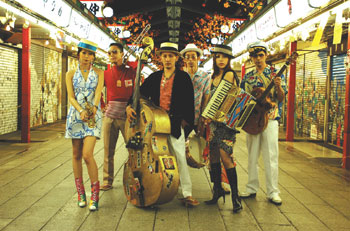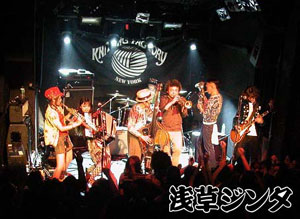Asakusa Jinta March back in Time
The Music Series > Asakusa Jinta > Boris > Shibusashirazu > Mad3 > Keiji Haino > Ghost > Overhang Party
Unless in search of a cheap, dusty souvenir for a relative, Tokyo's historic Asakusa district isn't on the radar of too many folks under the age of 70. But Asakusa Jinta, a seven-piece band that mixes elements of ska, swing, punk and chindonya (traditional street performance), is hoping to bring the area's time-honored sensibilities to the international stage.
 "There are old but good things," says vocalist Osho via e-mail about the Asakusa area. "The undeveloped image of the place is as if the clock stopped. The same Edo spirit has been there for years. Our music is out of respect for our ancestors of the area."
"There are old but good things," says vocalist Osho via e-mail about the Asakusa area. "The undeveloped image of the place is as if the clock stopped. The same Edo spirit has been there for years. Our music is out of respect for our ancestors of the area."
Osho doesn't say if his own ancestors were ever part of a jinta, street bands that once roved Japan's streets advertising shows or sales. They were popular in the Meiji Period (1868-1912) -- a time when the ideas of giri (duty) and ninjo (empathy) were much more valued than today, according to Osho.
"They are the source of laughter and crying," he says of the importance of the two concepts to the band. "I don't want to say it but they are disappearing."
Osho is not alone in his fondness for Asakusa's old days. His group's 2005 album "Asakusa Rock" included a track where the band set music to a poem by film director Takeshi Kitano, another denizen of the area. Kitano used to be an emcee at the France-za comedy-cum-strip club in Asakusa in the 1970s.
In a music industry of seemingly never-ending genres, Asakusa Jinta is likely the first to describe its approach as "hard march" -- a sound whereby an accordion, brass section, guitar, bass, and drums blend at a hummingbird-flapping-its-wings tempo to create the feeling of a marching band.
"Marching is a worldwide language," explains the vocalist, who also strums a stand-up bass during performances. "When we started [in 1999], marching seemed like a treasure to me. Though marching is not special and appears everywhere, I was sure we could create something new by concentrating our soul into it."
 Even so, the group's latest album "Sky 'Zero,' " released in January, begins somberly, with slowly lilting brass and accordion, before Osho's bass notes change the pace and sends the band into a frenzy suitable for a carnival crowd. From there on, the speed rarely slacks, with the jump-up, ska-inflected rhythms punctuated by Osho and his band members' yelping vocals.
Even so, the group's latest album "Sky 'Zero,' " released in January, begins somberly, with slowly lilting brass and accordion, before Osho's bass notes change the pace and sends the band into a frenzy suitable for a carnival crowd. From there on, the speed rarely slacks, with the jump-up, ska-inflected rhythms punctuated by Osho and his band members' yelping vocals.
But it's the ensemble's live show where Asakusa Jinta should really be heard. Outfitted in retro costumes of colorful hats and suits, the group get the crowd dancing as if it were attending a polka festival: Osho is like a carnival barker at the front of the stage, his deep vocals calling to the audience from the side of his bass; Hiro shakes to the rhythm with her accordion while Mikachinto freely swings her alto sax high above the crowd.
Asakusa Jinta's dynamic live display -- and the desire to actually march -- creates elbow-room challenges when playing indoors. At some points during a show, some more mobile parts of the band -- the brass section, for example -- find the space by simply marching into the audience. "We play naturally," says Osho. "It is hard to pinpoint our inspiration because we are a group of seven. But it is the mix of our different identities that makes for a good thing."
Last month, Asakusa Jinta brought this "good thing" to the South by Southwest music-industry showcase among 1,300 other bands in Austin, Tx., as a part of the "Japan Nite" touring group. For them, this first trip to the U.S. is simply a beginning. "We want to take our music around the world," Osho says. "We have to repay the debt of kindness paid by Asakusa's ancestors."
Note: This report originally appeared in the Japan Times on April 6th as a part of a package on music in Japan. Photos courtesy of Asakusa Jinta.
The Music Series > Asakusa Jinta > Boris > Shibusashirazu > Mad3 > Keiji Haino > Ghost > Overhang Party

